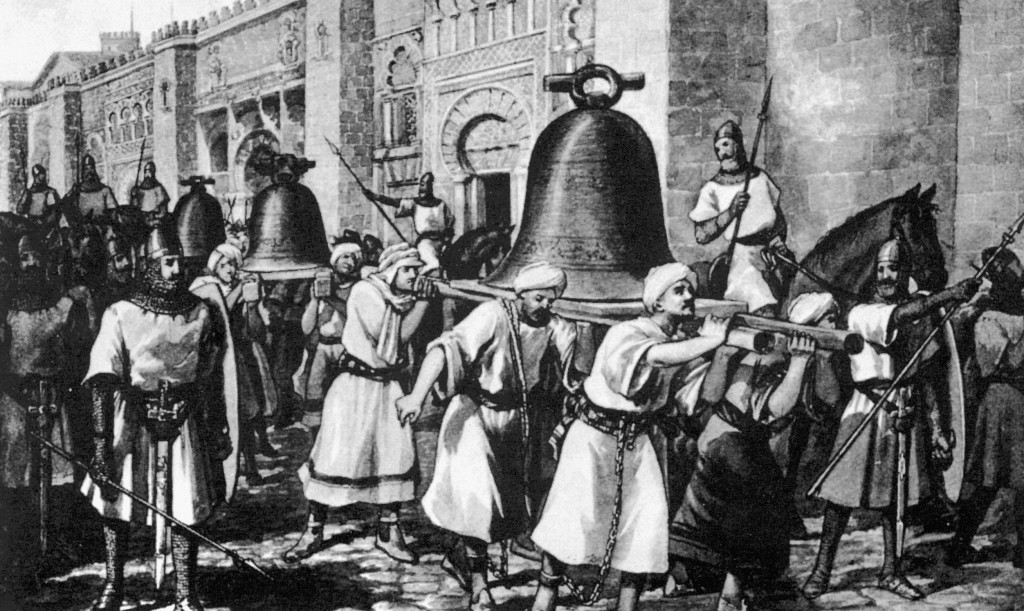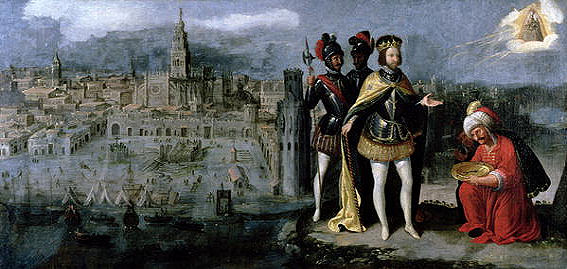
In 1224, with his internal political affairs resolved, [Saint Ferdinand III of Castile and Leon] turned his attention to the Reconquest, a military campaign that with a few short intervals occupied him for the rest of his life. Quesada, the first town to fall, was typical of the many that followed. The Castilians placed cloth-muffled ladders against the walls just before daylight. Fernando raced up a ladder, jumped on the wall first, and struck down an approaching guard with a firm gashing blow to his head. The other knights were just seconds behind. Shouting, “Santiago and Castile,” the Crusaders threw themselves into the fight to protect the life of their valiant King, who always seemed to be ahead of them. Slashing and cutting, they gained control of the wall and towers and opened the gates, allowing their army to rush in and capture the streets and squares. The first rays of the sun saw the town in Christian hands.
On the highest tower, Fernando, covered with Moslem blood from head to toe, planted the Cross and, gazing at it lovingly, prayed: “Knowest that I do not seek my glory but thine; not the greatest of perishable kingdoms, but the kingship of Christ on earth.” Throughout the next six years, Fernando raided central Andalusia, capturing most of the small towns, ravaging the countryside, collecting much booty. Only the three large cities of Cordoba, Seville, and Jaen avoided capture because of their massive fortifications and large garrisons….
One night during the cold, rainy season at the end of 1235, a group of adventurous knights scaled the walls [of Cordoba] and gained possession of one of the suburbs and sent word to Fernando explaining their precarious circumstances. Knowing that his vassals had exposed themselves to great danger for their Christian faith, the warrior-King immediately gathered up a few companions and rode rapidly for the next few days through rain and floods to bring needed relief. As spring came on, Fernando, with increased forces, captured the main defending castle at the opposite end of town, ravaged the Moslem fields, and tightened the siege. Late in June, Cordoba, once the ornament of the world, capitulated. For the next few weeks, village after village came out and watched in amazement as Moslem captives carried the huge bells of Santiago on their shoulders back to Compostela.

When Al-Mamsur conquered Santiago de Compostela and razed its church, he forced the Catholics to carry the large church bells to Cordoba, his capital. Years later, St. Ferdinand re-conquered Cordoba and obliged the Moslems to return the same bells to Compostella.
In 1246 Fernando besieged Jaen once again, having already failed three times. When it became evident that this time the fortified city would fall, the King of Granada, its master, knowing his own kingdom would be next, decided to cut his losses. He agreed to surrender Jaen and become Fernando’s vassal if the latter would allow him to keep the Kingdom of Granada, which included the port cities of Malaga and Almeria. Fernando approved and Granada became a vassal state of Castile, a status that it retained until 1492. The crusading Castilian could now turn his attention to Seville, the greatest city of Western Europe at the time.
Seville was situated on the west or left bank of the Guadalquivir River sixty miles from the Atlantic Ocean and was connected with its suburb, Triana, on the opposite bank by a bridge of boats. The river downstream, actually an estuary, was navigable. Fernando’s first task was to break the ring of walled towns and fortresses within a twenty mile radius that guarded the approaches to the city. The residents of those towns that capitulated could remain unmolested in their homes but had to turn over the citadels and fortifications to the Castilians. The towns that resisted were captured and the inhabitants killed.
Since the Guadalquivir was navigable up to Seville, naval vessels played an integral part in the investment of the city in order to cut off communications and supply routes. The Spanish Admiral Ramon Boniface assembled a fleet in the bay of Biscay, brought it around the peninsula, and after several engagements gained control of the river. His most spectacular success came in May 1248 when two large galleys rammed the bridge of boats with such force that the chains which held the boats in place snapped, allowing the current to carry the two halves harmlessly to shore.
The siege reached a critical stage during the summer, when famine, disease, and terrible heat brought unbearable suffering to both sides. The moral elements of fortitude and determination gained in priority, which gave the advantage to the Christians because of their battle-hardened warriors, a large number of whom were the devoted monks of the military religious orders. The Moslems capitulated in November and after lengthy negotiations agreed to evacuate the city along with its dependent villages. Hundreds of thousands of Mohammedans under Christian escort retired to Granada or were transported to North Africa.
The privations and austerities of camp life and the rigors of his spiritual life had destroyed San Fernando’s health, and he died shortly after in 1252. The great Crusader, whose body is whole and incorrupt to this day, was revered as a saint long before his canonization in 1671.

The incorrupt body of St. Ferdinand in the Royal Chapel at the Cathedral of Seville.
Jeremias Wells, History of Western Civilization (n.p., n.d), pp. 259-262.
Short Stories on Honor, Chivalry, and the World of Nobility—no. 66









